Field exercises test Arctic survival readiness
Personnel safety is a priority in offshore operations, but it becomes particularly challenging in extreme environments. In Arctic conditions, demands on survival equipment are intensified, and the execution of search-and-rescue (SAR) operations differs dramatically from those same operations carried out in more temperate environments.
In a program designed to test the industry’s ability to contend with Arctic safety issues, ABS joined the University of Stavanger, GMC Maritime, the Norwegian Coast Guard, and other industry and academic participants in a full-scale research exercise, called SARex 2016, in Norway’s Svalbard archipelago during April 2016. The exercise, carried out from the Norwegian Coast Guard vessel KV Svalbard, simulated an emergency scenario involving a passenger vessel/cruise ship in the High North, but which could be extrapolated to similar situations involving mobile rigs, floating production platforms or vessels, and other related ships.
The International Maritime Organization’s (IMO’s) International Code for Ships Operating in Polar Waters (Polar Code), which enters into force on Jan. 1, 2017, brings with it a broad spectrum of binding regulations, including elements of ship safety; equipment; design and construction; and operations and manning for vessels operating in polar waters. Of particular interest to the SARex research team is Chapter 8 of the Polar Code, which contains regulations for lifesaving appliances and arrangements providing for safe escape, evacuation and survival.
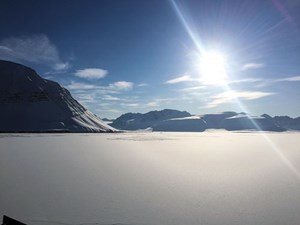
The goal of SARex was to advance understanding of the risks associated with Arctic operations, and explore any gaps between the functionality of existing Safety of Life at Sea (SOLAS) approved lifesaving equipment and the functionality required by the Polar Code.
RESEARCH RELEVANCE
The Crystal Serenity cruise ship, carrying more than 1,000 guests and 600 crew members, recently completed its journey across the Northwest Passage. While this was a successful journey, previous transits—the MVWilliam Carson (1977), the Maxim Gorky (1989), and more recently, the Explorer (2007)—resulted in close-call situations that jeopardized personnel safety. This component of the SARex exercise simulated a sinking cruise ship and a mass rescue scenario in the High North, with the goal of identifying potential risks and risk mitigation strategies.
There are many realistic scenarios that could impact the success of a rescue in this type of harsh environment, Fig. 1. If it were evening, when the cruise ship encountered an emergency, most of the passengers would be at dinner or possibly on deck watching the Northern Lights. As the ship began to list, passengers would panic. In such a situation, would passengers have time to return to their rooms and change into thermal clothing, or would they go directly to the muster stations? Would there be enough thermal clothing at the muster station for all of the passengers? Would the crew be able to evacuate passengers into life rafts or lifeboats quickly, or would the passengers be scrambling to find friends and family before leaving the vessel? What happens to older passengers and passengers with physical limitations that impact their ability to follow evacuation procedures? And how would age and fitness affect the length of time a person could withstand the cold? In an environment with strong winds and high waves, there would be additional stress on passengers of all ages and physical abilities. How would these factors impact survival times?
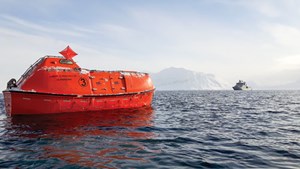
FIELD TRIALS AND FINDINGS
The goal of SARex 2016 was to determine if present safety and evacuation plans have sufficient provisions to allow passengers to survive for a minimum of five days—a requirement of the Polar Code. This exercise included three phases of research that examined aspects of SAR operations in the Arctic:
- Phase One evaluated whether people could survive in a lifeboat or life raft in polar waters for up to 24 hr (much shorter than the minimum of 5 days/120 hr outlined in the Polar Code) by wearing different levels of thermal protection (thermal life jackets and various immersion suits), Fig. 2.
- Phase Two evaluated Norwegian Coast Guard rescue operations from a lifeboat, to simulate a mass casualty situation with different types of injuries.
- Phase Three evaluated the capabilities and limitations of the life raft, and other lifesaving appliances (personal and group survival kits), and their adequacy in polar waters.
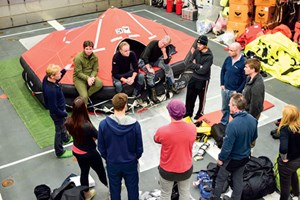
For the duration of these exercises, weather conditions were calm, with sunny skies, virtually no wind or waves, an average air temperature of –10°C (14.0°F) and a water temperature of –1°C (30.2°F). These conditions represent a best-case scenario for a typical cruise ship season in Svalbard and the surrounding areas.
LIFEBOAT, LIFE RAFT SURVIVAL
Participants in this exercise included research team members and Norwegian Coast Guard personnel, a healthy and fit study population that entered into real-life scenarios to test their abilities to survive in polar waters for up to 24 hr, Fig. 3. A group of 22 participants, in a 55-person lifeboat, and a group of 20 participants, in a 25-person life raft, were randomly assigned to wear different levels of SOLAS-approved thermal protection. All participants wore standard, long woolen undergarments under a shirt and pants paired with the assigned thermal protection. Table 1 shows the name and description of the different insulated and uninsulated immersion suits, neoprene immersion suits and thermal life jackets worn.
The goal was to determine how long protective equipment was effective, with a level of ineffectiveness reached when:
- Hands and feet were numb or the participant experienced shivering
- Participant was unable to complete a simple physical test (unscrewing a bolt)
- There were notable changes to the participant’s physical appearance.
When any of these criteria were met, the ship’s doctor carried out wellness checks, as each participant left the survival craft.
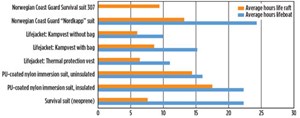
The findings from Phase One show that both the type of survival craft—lifeboat or life raft—and the form of thermal protection affected how long people were able to withstand the cold. Figure 4 shows the average number of hours that participants lasted in the lifeboat and the life raft, while wearing each form of SOLAS-approved personal protective equipment.
EQUIPMENT EFFECTIVENESS
Although it is not possible to determine from this study what form of thermal protection will keep a person alive for the longest time, it is apparent that the type of thermal protection worn significantly impacts the length of time that a person would be able to remain in a survival craft.
Not surprisingly, the insulated immersion suits performed best because they provide whole-body thermal protection. The neoprene survival suit performed well in the lifeboat because there was no exposure to water or wetness. However, the neoprene suit proved to have the biggest variance in performance between the life raft and the lifeboat, which is concerning, because there is a good chance that a passenger would be exposed to water. Because the lifejackets worn in the study did not offer full thermal protection to arms, legs, hands or feet, participants wearing life jackets were the first to leave the study in both the life raft and the lifeboat.
Preliminary study conclusions suggest insulated immersion suits should be a requirement for vessels operating in Arctic environments, because they offer better thermal protection. The study also yielded information that led to suggestions for Arctic survival suit standards:
- Full-body thermal protection (including hands and feet)
- Additional zippers on the suit to facilitate bathroom needs
- Material/fabrics that promote ventilation
- Suits adaptable to body size
- Pockets within the suits for storing food, water, flashlight, etc.
Another important issue identified in Phase One was the poor air quality in both the life raft and lifeboat. For safety reasons, portable oxygen (O2) meters were used in each craft. Every 20 min. to 30 min., the O2 meter alarm sounded in both crafts, indicating ventilation was required. This took the form of opening entranceways or hatches. Each time a craft was vented, the temperature within the survival craft dropped noticeably, which posed an additional threat to personnel survival.
Today, survival craft are not required to have an O2 or CO2 alarm, which means it is quite possible to exceed safe levels without occupants being aware of the need to circulate fresh air through the survival craft. Existing research and conclusions from this study indicate that all survival craft should be equipped with a way to measure air quality or, alternatively, that improved ventilation options should be provided.
MASS RESCUE FROM A LIFEBOAT
Phase Two simulated an Arctic cruise ship rescue from a lifeboat in which many of the passengers have sustained injuries. Again, such a scenario could just as well apply to rescue from a mobile rig or floating production vessel. In this scenario, the passengers would have survived for a certain amount of time in a lifeboat, and would more than likely be suffering from various illnesses/injuries. To make this exercise as realistic as possible, approximately 40 participants were loaded into a 55-person lifeboat and assigned an illness/injury (hypothermia, broken leg, head injury, etc.) before the start of the simulation. This way, Coast Guard respondents would be aware of each person’s condition when they arrived to carry out the rescue.
The Coast Guard team had to determine how to triage the casualties (urgent vs. non-urgent injuries), then plan and allocate resources to get the entire group back to the rescue vessel as quickly and safely as possible. To increase the realism of this exercise, there was a simulated helicopter arriving from the nearest hospital to provide further medical personnel and assistance.
Findings from this phase of the study were very beneficial to the Coast Guard team, which learned:
- While the lifeboat was not filled to capacity, it was difficult for medical staff from the K V Svalbard to enter the lifeboat and assess the situation, to determine priority for medical treatment.
- Leadership was imperative on the rescue team because of the chaos and panic among the injured survivors, which led to erratic, unruly and disruptive behavior.
- There was no time to fully assess the condition of each person in the lifeboat, so a quick assessment resulted in more people getting treatment quickly.
- It was challenging to treat injured people in the lifeboat because of the seating arrangement and lack of space. It was more important to get people out of the lifeboat and back to the vessel for treatment, than to assess injuries in the lifeboat.
- When the casualties arrive at the vessel, it is important to execute efficient triage following clear procedures by a well-trained crew.
- If the majority of people in the lifeboat were in poor health conditions (mild hypothermia) when the Coast Guard/rescuing body arrived, it could put a major strain on their resources. It was much easier to rescue passengers who were able to help themselves and others (those who had relatively good dexterity, cognition, ability to understand instructions, muscle coordination and strength).
TESTING LIFE SAVING EQUIPMENT
Phase Three was conducted in two parts. Part one involved filling the life raft to capacity (25 people) and using the paddles to row the life raft to an ice edge from open water. The persons-onboard (POB) capacity was an issue. In this case, five people were lying on top of one another in the middle of the raft because there was no space to sit. This situation was unsafe and risky, even for a short duration (20 min. to 30 min.). It demonstrated a major concern, if survivors had to spend a prolonged amount of time in this cramped space awaiting rescue.
Another risk factor identified was the length of the paddles. They barely touched the water. To gain enough force to paddle, the two participants in charge of rowing the raft had to lean most of their body out of the entranceway. This concern could be resolved by fitting the raft with adjustable or retractable paddles that would not require additional storage space in the raft. Based on existing research and the present study, the POB capacity for survival craft, including both lifeboats and life rafts, should be re-evaluated to account for the additional space required for safety equipment and human anthropometrics while wearing the thermal protective clothing.
Several characteristics of life rafts bring into question the suitability as survival craft in the Arctic and harsh environments. Concerns included the rafts’ lack of self-righting behavior; their lack of insulation for the Arctic climate; the potential for the raft to puncture; the necessity for the crew to launch a life raft into the sea or onto an ice floe; and the dangers associated with passengers/crew being exposed to the environment while loading into the raft, once it is inflated in a safe location.
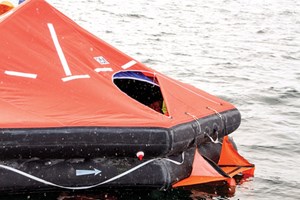
The Polar Code states, “no lifeboat shall be of any type other than partially or totally enclosed type” (8.3.3.3) for operation in Arctic waters. This is clear guidance. However, the Polar Code does not prohibit the use of life rafts, which means their utilization is left to the discretion of the owner or operator, Fig. 5. More research needs to be done, to determine whether an “Arctic” life raft is truly a viable option in this type of environment.
Once passengers safely evacuate a vessel into a survival craft (lifeboat or life raft), they must figure out how to survive with the lifesaving equipment provided. Part Two of this phase involved evaluating the adequacy of the equipment in both the group and personal survival kits for use in Arctic environments. Equipment requirements for these survival kits are listed in Polar Code Chapter 8:8.3.3, Survival.
The group and personal survival kits included many practical items for use in an Arctic environment. However, one of the items that raised concerns was the tent provided. It was extremely difficult to set up and required a lot of people working together to successfully erect it, which was particularly challenging for survivors wearing Arctic gloves/mittens.
In this type of climate, it is important that the shelter provided has the following characteristics:
- Clear instructions (what languages should be considered? Should multiple languages be used?)
- Easily assembled
- Requires very few people to erect
- Lightweight
- Tested in, and suitable for, harsh environments.
Another interesting finding from this study was that the life raft could function as a form of shelter. Some of the benefits of the life raft as a shelter include the following:
- Easy to inflate
- Relatively easy to pull onto the ice, assuming there are people capable of assisting
- Easy to move back into water, if there were danger on the ice (such as a polar bear)
- Double-insulated bottom, which offers additional thermal protection and comfort as a sleeping place (air mattress)
FUTURE RESEARCH
This research scratched the surface of many possible challenges associated with increased activity and operations in Arctic waters. Although it is not possible to determine from this study what form of thermal protection will keep a person alive for the longest period of time, the exercise showed that the type of thermal protection significantly impacts the length of time a survivor would be able to remain in the survival craft.
Another critical finding is that even with a healthy group of participants and excellent weather conditions, risks during SAR operations can be very serious. If sea conditions and weather were more severe, or if evacuees were experiencing the many stressors associated with an emergency, the results could have been much more negative.
Primary findings suggest that the industry may find it challenging to meet the Polar Code requirements for five-day survival in polar waters. And implementing the functional requirements for escape, evacuation and survival also may prove difficult.
The results of the Svalbard study indicate that further research is needed in the following areas:
- Survival craft performance in harsher weather conditions, for longer periods of time
- The adequacy of thermal protection after it is exposed to water
- Testing of additional life-saving equipment in ice and polar waters
- Air quality and ventilation of lifeboats and life rafts
- Passenger capacity for lifeboats and life rafts
- The transfer of passengers from a life raft or lifeboat to a vessel or onto ice
- Similar studies in controlled conditions (lab setting).




